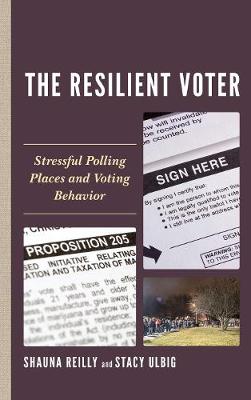Voting, Elections, and the Political Process
2 total works
The Resilient Voter: Stressful Polling Places and Voting Behavior provides a new perspective on the role voting barriers play, demonstrating that they not only discourage participation but also affect the quality of votes cast. Offering an interesting and unique approach to the study of voting barriers, Shauna Reilly and Stacy G. Ulbig investigate the possibility that complicated ballot language, provisional voting, and long polling place lines cause some voters to cast ballots in a manner contradictory to their preferences.
Building on arguments that stressful polling place conditions subject citizens to stress that can prevent them from casting complete ballots or even choosing to vote at all, the authors ask whether those who endure polling place frustrations and persevere to cast a ballot might become so stressed by their experience that they are unable to mark their ballots in a manner consistent with their standing policy preferences. Using a creative experimental design, the authors examine the ways in which complex ballot language, registration difficulties, and long polling place lines affect voters' stress levels, and how such anxieties translate into the willingness to cast a complete ballot and the ability to vote in a manner conforming to previously expressed preferences.
The authors demonstrate that even though most voters prove remarkably resilient in the face of some potentially stressful polling place barriers, they are not immune to all polling place conditions. Further, they illustrate that some segments of the electorate tend to be more vulnerable to polling place stressors than others and illustrate the ways in which the compound effects of multiple barriers can exert an even wider impact.
Building on arguments that stressful polling place conditions subject citizens to stress that can prevent them from casting complete ballots or even choosing to vote at all, the authors ask whether those who endure polling place frustrations and persevere to cast a ballot might become so stressed by their experience that they are unable to mark their ballots in a manner consistent with their standing policy preferences. Using a creative experimental design, the authors examine the ways in which complex ballot language, registration difficulties, and long polling place lines affect voters' stress levels, and how such anxieties translate into the willingness to cast a complete ballot and the ability to vote in a manner conforming to previously expressed preferences.
The authors demonstrate that even though most voters prove remarkably resilient in the face of some potentially stressful polling place barriers, they are not immune to all polling place conditions. Further, they illustrate that some segments of the electorate tend to be more vulnerable to polling place stressors than others and illustrate the ways in which the compound effects of multiple barriers can exert an even wider impact.
This book examines the voting restrictions that have been implemented across the United States in the post-2008 recession era. Navigating the literature and conventional wisdom, this book navigates the fiscal, partisan and racial influences on voting rights laws in a post-recession era. Reilly explores the role each of these three influences have had on policy and culminate in a trifecta of effects. This is the first contribution to the literature that explores fiscal impacts with the interaction of race and partisanship.

